‘Never before have we had such an important presence to represent Italian gastronomy!’ Applause. The strange case of John Regefalk: he, a Swede from a village near Malmö, speaks (excellent) Italian but with an obvious Roman lilt, a legacy of his experience as Roy Caceres' sous chef at the then Metamorfosi in Rome. Now, however, he’s in charge of the Innovación Culinaria sector of the Basque Culinary Center in San Sebastian, so he is the right person, with Paolo Marchi, to introduce 'Italy at the Basque Culinary Center', an event held a few days ago at the prestigious Basque gastronomic research centre. An idea born while dining, as Basque Culinary Center director, Joxe Mari Aizega, recalled here. Regefalk again took the floor: ‘Italy is a complex country even in terms of food, that is, with so many differences. The speakers will convey not only their vision, but also these thousand facets of Italian food: territory and product, tradition and avant-garde’. Marchi confirms: ‘Yes. Italy has long been condemned to being considered only the home of pizza, pasta, risotto.... But there is much more, there is lots of creativity. And we are here to prove it. It's not easy: on average, foreign tourists come to Rome or Venice and are so surrounded by beauty that they don’t pay much attention to what they eat. This holds back our most talented chefs, even though they’re doing an amazing job. So it is right to give them space, as we have done.’
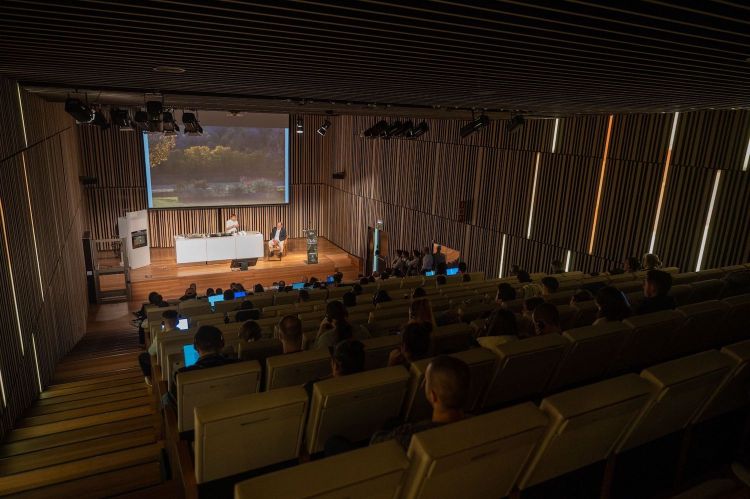
Here is a quick review of the talks given to the Basque students who took plenty of notes.
ANTONIA KLUGMANN
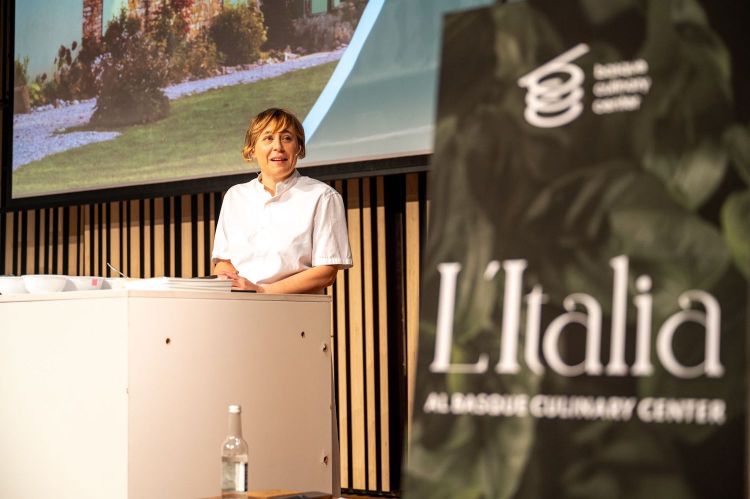
Antonia Klugmann and, below, the Biancoperla corn dumpling
'
Territory - Life on the move' is the name of the extensive menu that
Antonia Klugmann offers at
L’Argine, on the border with Slovenia. She remembers this name because it is representative of her style in the kitchen, ‘for me it means changing repeatedly throughout my career, to be in continuous evolution. Seeking stimuli in products, better if poor, simple, local. If products are always the same, what changes is the cook's approach, so their food becomes a representation of themselves, at a specific stage in their personal gastronomic research’. The snapshot that
Klugmann proposes at the
Basque Culinary Centre is given by a Biancoperla corn dumpling that refers to the food tradition of the Northeast, to polenta, but also becomes ‘a symbol of a path towards understanding agriculture’, essential for a contemporary chef. That is: ‘Sustainability is also being aware of water and soil resources, rationalising the efforts in the kitchen so that there is no waste of either food or energy... It is a practical path’. This Biancoperla corn grows in Polcenigo, near Pordenone; ‘a dear friend has spent 4 years selecting seeds in a specific soil. Corn knows how to adapt. It didn't get an ounce of water, not even in the hottest year ever, when a lot of intensive farming didn't make it. How is this possible? Because they respected the richness of the soil through rotation and selected seeds suitable for that climate. This is the cook's task, as we get ready to face perennial scarcity: technique, instinct, sensitivity. It is not only enhancing biodiversity but also choosing to use plants that have developed specific features for a given soil’. But why is this gnocco “different”? It is made with Biancoperla corn polenta flour and is served with a fresh corn broth and corn purée. Cooked on cast iron, it caramelises a little. It is seasoned with juniper oil and Parmigiano Reggiano, ‘the former because it gives us pure aromas. Then the Parmigiano water (extracted by blending the cheese, ‘without cooking, the chef takes a step back out of respect for this exceptional product’) is used to glaze the gnocco. Finally, they sprinkle some glucose powder and pass a blowtorch. Second dish, pasta: the chef uses the capellino format, thin, which she cooks in a broth obtained from cardoons ‘from my vegetable garden, nice and bitter’ (infusion? Marinating? Vacuum-packed? No: they remove the outer leaves, put it in a saucepan with oil and herbs, stew over high heat, add water, then continue cooking for fifteen minutes). Then Castelvetrano green olive puree, ‘extraordinary, complex, bitter, sour, long’; liquorice water; nice fat yoghurt.
ANDREA TORTORA
People, faces, time.
Andrea Tortora tells his story through these words, and others too, having designed (and then accomplished) his career path as a journey, based on concepts such as meeting, confrontation and freedom. At the
Basque Culinary Center,
Tortora talks about the Italian sweet art; and he talks about panettone, ‘the most well-known and imitated confectionery product in the world. It requires knowledge, time, technology, research’. Today at his
At Patissier he makes 50 thousand pieces: per year? No, in two months, only November and December, ‘my idea is never to stock anything, to always sell a freshly made goodness’. And then: ‘For me, the perfect product is when there is nothing left to take away, I work by continuous subtraction’. His method: ‘I take all the technique, immediacy, and rigour from a kitchen brigade and use it in pastry making. Chefs are 100 years ahead of us pastry chefs’. He reviews his creations: ‘We have given a new look to bread cake, a poor man's dish’. Then, paradoxically: ‘Everyone talks about how to reuse leftovers. But wouldn't it be more logical and useful to produce less, and then not having to rack our brains about how to use leftovers?’.
At Patissier he works practically only on commission. ‘We will produce the panettone cakes we have already sold, since August. So we also have the liquidity to pay employees, suppliers and to be able to grow’. A logic of... slowing down the pace, which is not pulling the oars in the boat,
Tortora is in fact very active on the innovation front, ‘we have created a panettone without butter, very good, we use olive oil with very low peroxides’. And with an eye always on what is happening outside the door: ‘Drawing inspiration from others is important, it makes us look at things differently. Years ago I was in Singapore, I baked a magnificent loaf of bread, nice and crispy. An Asian student of mine came and said: ‘But where did we go wrong? I only understood after a while: for them bread is
sponge bread, soft, the crunchiness is a problem, a mistake’. A final piece of advice to the
Basque students: ‘Don't seek perfection, it makes no sense, it only feeds your ego. Prefer simplicity, which surprises the diners and makes them happy’. Stress-free.
FEDERICO CERETTO
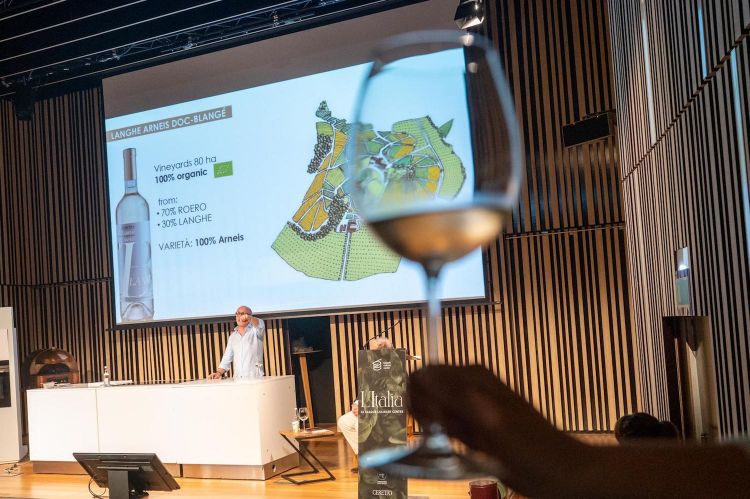
The lecture-tasting by Federico Ceretto
Two great Italian partners accompanied
Identità Golose on this trip to San Sebastian, both of whom were the protagonists of tastings in the auditorium, the
Basque students immersing themselves in the extraordinary products of which Italy is capable. The first to talk is
Federico Ceretto from
Ceretto Aziende Vitivinicole in the Langhe. He recounts how his land is the most visited wine-growing area in Europe, ‘but the value and quality of the guests who come to us also derives from the fact that our gastronomic culture, our restaurants, our chefs are of the highest level’. He knows something about this as his family launched
Piazza Duomo.
Ceretto immerses us in his reality and offers two tastings. The first is of
Ceretto Langhe Arneis Blangé 2021, ‘I cannot experiment with Barolo, it has existed for.... twenty-five generations? Thirty? Fifty? It has its own history, each generation has added a little piece to get as far as possible’. As for white wines, on the other hand, there was free field: hence the choice to focus on Arneis, an indigenous variety, ‘it was a small revolution, a wine that didn't exist before. It was much appreciated’. Finally, space was given to His Majesty:
Ceretto Barolo 2018 Docg, needless to say. Final note: ‘I am proud to have accompanied
Identità on this trip. The comparison between the great Italian craftsmanship and the
Basque gastronomic research is truly extraordinary’.
FRANCO PEPE
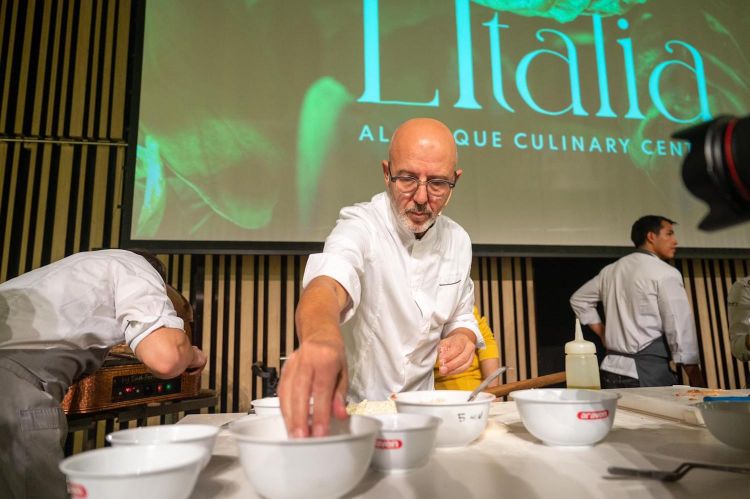
Franco Pepe and below the Acquerello Capriccioso pizza
‘Doing new things with pizza is extremely difficult,
Franco has succeeded,' says
Paolo Marchi.
Pepe takes the stage smiling and has a (sacrosanct) dig, 'twenty years ago I would never have thought I could enter a school like this. In Italy we are still waiting for them to train us pizzaioli, maybe that's why there is so much squabbling, because there is a lack of knowledge', to put it in a gentle way. In other words: there are too many ignorant and presumptuous people.
Pepe in Grani is further ahead, 'we have always focused on training and hospitality. Once upon a time, the identity of a pizzeria was focused on the pizza chef. Instead, I have created a great team. While I’m away, here in Spain, we were able to satisfy 350 people, last night at
Pepe in Grani, because the identity is now in the dish', that is, in the pizza. In Caiazzo there are chefs, people by the counter, bakers... Everyone knows what to do, while
Pepe elaborates ideas, 'you can't always remain stuck to tradition alone. I questioned my father's work and my son will do so with mine. Otherwise, you don't grow, you don't evolve'. The basic idea is still that pizza is a popular product 'and it must remain so. But then I work on some techniques to transform raw materials and this allows me to take steps forward'. Like
Margherita mista, which exalts the tomato, placed at the end of the cooking to enhance its excellence. ‘Adjusting pizza Margherita in Campania was complicated. But today many pizzaioli from all over the world write to me telling me that I inspired one of their creations'. He proposes another one that will create some noise: a Capricciosa 2.0, he called it
Acquerello Capriccioso: 'There are pizzas that are forgotten. Pizza
Capricciosa in the '70s and '80s was very popular, it was topped with everything the pizzaiolo had on the counter', abundance at the expense of quality; a lot of elements that were too moist all together; a
mappazzone some would say. So here is
Pepe's refined version: 'I work in the kitchen on the various elements and then place them on the pizza so that they are balanced', dehydrated caiazzane black olives, ditto the capers, the tomato becomes a silpat sheet, then basil sauce, mushrooms in tempura, not anchovies but anchovy colatura... The rest is done by the customer:
Pepe brings him the base, then he will season to taste, to complete the work.
RICHARD ABOU ZAKI and PIERPAOLO FERRACUTI
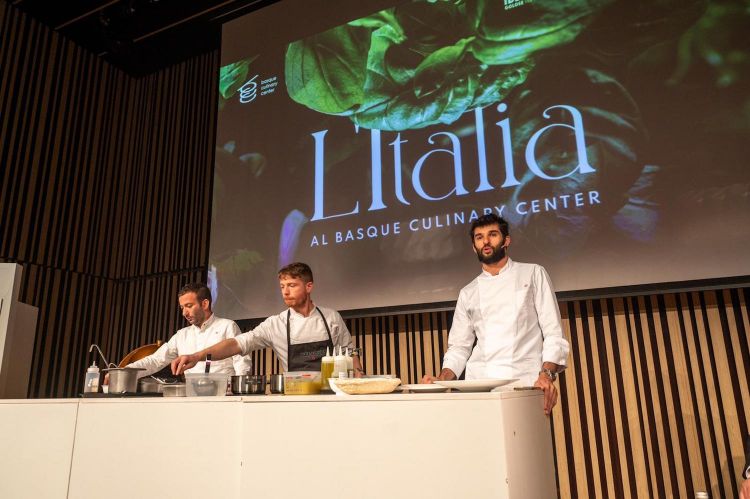
Pierpaolo Ferracuti, Richard Abou Zaki and below, Riso Adriatico
From a great master to two young talents, because the Italian delegation at the
Basque Culinary Centre is composite and complete.
Richard Abou Zaki and
Pierpaolo Ferracuti tell of how their work is based on the concentration of taste, research, study, experimentation, without ever neglecting the emotional aspect 'that can come from a distant memory or in any case from what we already know and can be transmitted through technique'. Their lesson is on risotto, or rather on rice (Vialone Nano from the Po Delta 'left to dry, it releases the starch, the grain is rounded, it ensures a nice texture) interpreted in three dishes, always with broths in which the cereal is risottoed. The first is
Riso Adriatico, now a signature dish, 'we like the idea that it only takes a mouthful for the guest to understand this is one of our dishes'; it valorises a local product, 'near Porto San Giorgio there is Ascoli, where a speciality is stuffed olives,'
Marchi explains to the Spanish audience, 'they are local olives, the Tenera di Ascoli variety, big, they give little oil but have a lot of pulp, so they are perfect for a dish like this.
Abou Zaki: 'They are very crisp, bitter, with a beautiful balsamic aroma. I like them when they are still unripe, they remind me of tomato leaves or fig leaves'. The two take some olives in a 'classic' brine to which they add 10 per cent of olives in natural brine, they call it 'ancestral', i.e. without the use of soda, it takes 9 to 12 months to make them edible. ‘We cold-press, add a hint of tomato distillate, turbot stock for the collagen that provides a component that one would say is fatty but is not, there is no butter and no sautéing or hot broths either (‘Only frozen broth, to keep the flavour essential, sharp, pure’). On the bottom, some amberjack as a surprise: the dish is ready. The second rice is with fermented peaches (3.1% salt to start the fermentation, 'it's a lot but the fruit is full of sugar, it stays 21 days at a controlled temperature of 18-20°C, it loses the sweetness, the intensity of the peach remains, there is a hint of green apple to give freshness'). On the base, sea urchins, 'bitter notes that contrast with the acidic and sweet ones', then peach rice, then burnt orange paste for the citrusy and toasted part and a hint of chilli oil. Finally, a sweet rice, with alkermes (a solution of water and alkermes by
Paolo Brunelli, low in alcohol) with angostura, a knob of vanilla butter, on the base a reduction of chinotto, bergamot and citron: recalling an English trifle. 'The concentration of flavour that these broths manage to release once they are absorbed by the rice and receive its starch, becoming creamy, is incredible'.
LUIGI DATTILO
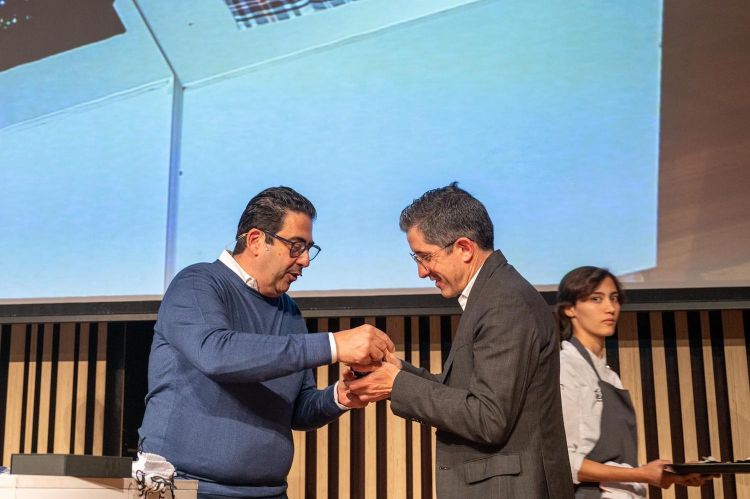
Luigi Dattilo (left, with Joxe Mari Aizega) and Appennino Food Group truffles
After
Ceretto, another great partner for '
Italy at the Basque Culinary Centre'. It is the
Appennino Food Group, on stage its founder
Luigi Dattilo, who is a guarantee: his presence ensures there is great truffle, together with a deep and passionate competence in knowing how to talk about it. ‘He has developed the concept that there is not only the white truffle of Alba, but you can have excellent qualities, exciting and perfect for countless combinations, throughout the year,’ says
Paolo Marchi.
Dattilo explains: 'For a couple of years now, we have been carrying out an important project, namely to support chefs who want to know more about the world of the precious hypogean fungus’. There are around 100 varieties of truffle in the world, 'its function is to absorb mineral salts to nourish a plant in difficulty, obtaining sugars in return'. A wonderful symbiotic relationship and complicity, 'the same that the truffle can find with the ingredients in the kitchen'. Everyone talks about the white truffle 'because it is a simple product, easy to use, you just need to slice it on a fat base to accompany its aromatic notes'. But 'from my point of view, there is much more to discover. For example, there are no less than five different types of fresh truffles available in December', he knows all their characteristics inside out. A final highlight: Italy is the only country that has all six truffle species in the world that can be used in cooking. There is plenty to indulge in.
GIANLUCA GORINI
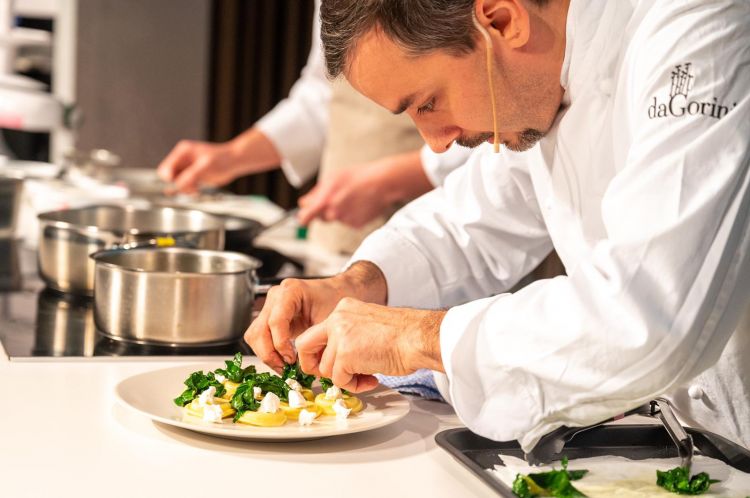
Gianluca Gorini and, below, his liquid shallot ravioli
Excited and emotional,
Gianluca Gorini starts with a memory: 'I used to come here to San Sebastian many years ago, when I was very young, to attend
Lo Mejor de la Gastronomia. I used to see the great chefs on stage... Now I find myself giving a lecture. So I wish the
Basque boys to achieve their goals. If they have perseverance and desire, they will achieve them'. Then the story begins, which is an immersion in Gorini's Italy: 'In Bagno di Romagna, my village, times are marked by the rhythm of nature, of the seasons. It is a place that exudes authenticity and hospitality', the chef is in love with it. And authenticity also expresses his
DaGorini. I want my guests to feel good first and foremost, not just to enjoy good food. This is the Italian soul, our pride: the restaurant as a place of conviviality, exchange, meeting, where you can be with your loved ones.
Sara [
Gorini's partner] in 2017 had the strength to take me there, to something real. I am happy about that. This place represents our bond, our home. It was the right choice because you must always be faithful and consistent with yourself'. Bagno di Romagna allows this, 'offering extraordinary biodiversity: game, herbs, berries, mushrooms, truffles. I pride myself on having built a small network of local suppliers and gatherers, it is wonderful when a farmer knocks on the door to bring us two rabbits: it means having created simple, close ties that protect and preserve people's knowledge. Every now and then someone asks me: 'But why did you come to Bagno?' Then they remark: ‘Of course, it's beautiful here!’. And they don’t realise that they have already answered themselves’. The chef presents a dish based on fresh pasta, 'Romagna is the land of fresh-egg-pasta rolled with a rolling pin': a raviolo filled with liquid shallot and served with dried chicory, 'bitter', and fresh goat cheese, 'with a marked acidity'. The shallot from Romagna Igp is vacuum-packed for two hours at 80°C, to extract the liquids without oxidation. The resulting juice is thickened with agar agar,
Gorini obtains solid discs that serve as filling for the ravioli. The rest goes without saying. ‘It is a dish full of personality, persistence, intensity of flavour. Customers read it on the menu and maybe don't order it, it seems too simple. So I put it in the tasting menu, they taste it and then they are full of praise'. A final thought: 'The raw material gives me energy, what surrounds me is nourishment and inspiration for my creativity'.
FABIO PISANI
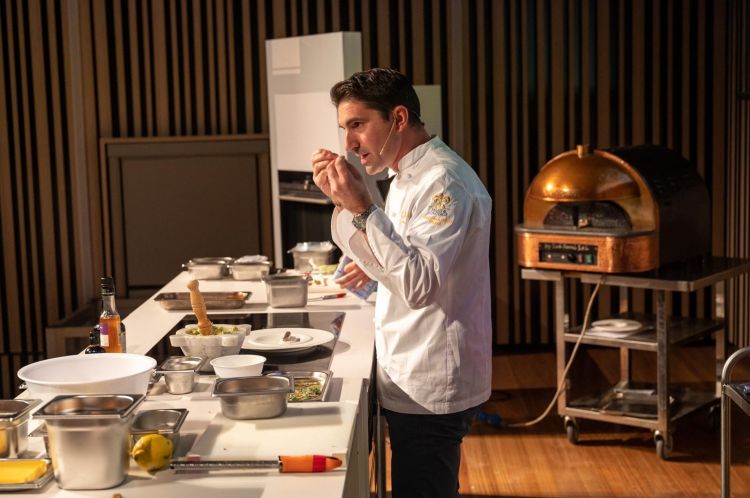
Fabio Pisani and, below, his contemporary carpione
There is little to say,
Il Luogo has been a beacon of good Italian food for sixty years, ‘you go there to eat Italian cuisine, fresh and excellent raw materials’, explains
Paolo Marchi introducing the second-last lesson, the one that featured one of the two chefs who have picked up the legacy of
Aimo and Nadia Moroni and projected it into the future: Apulian
Fabio Pisani. He did not disappoint the expectations (at the end of his lesson,
Aizega was enthusiastic) and recounted how, in the now consolidated work of selecting Italian excellence that has always characterised the restaurant in Via Montecuccoli, he and his colleague
Alessandro Negrini introduced a further step: ‘We have managed to do something very nice and which I’m glad to share with you. This is the
Territori project, 'the way to further develop the identity of
Il Luogo in an evolution based on history'.
Territori means the safeguarding of raw materials and the creation of a continuous connection between chef and supplier, ‘enhancing ingredients with the concrete and sustainable intent of rediscovering, recovering and promoting Italian excellence such as crops, breeding, products, history and techniques to give life to unique dishes or tasting experiences’. Basically, an axis is created between
Negrini-Pisani and the small-scale producers of fine food adhering to the project: they interact with each other, one offers ideas, creativity and a market outlet, while the others provide the mouth-watering products. So far six have joined, from all over Italy, 'we put our signature on it, we make the product unique. Like our Colonnata lardo', to which the chefs give a particular aroma, with notes of lemon. 'We select methodically and on the basis of a code of ethics, we create a beautiful synergy', under the banner of a motto: knowledge to be avant-garde.
Pisani then presents a dish, a sort of contemporaryised carpione: in the form of a gel, it goes into the planetary mixer to create an emulsion, a cloud on which the chef places a marinated anchovy from Camogli stuffed with pesto and Trentino walnuts from Bleggio, 'small, with an explosive flavour'. Then Tuscan fennel with chickpea flour from the Murge, 'we make a cecina that we fry to give it crunchiness'. It is completed with
Il Luogo’s lardo, pounded in the mortar, with a
lampascione prepared with raspberry vinegar and honey, and with candied lemon for the citrus side. The tour of Italy is served. ‘Memory leads you to emotion. It is the road we intend to keep on beating'.
PAULO AIRAUDO
Grand finale with an Italian... special. We are talking about
Paulo Airaudo, an Argentinean of Piedmontese and Sicilian descent, stars and restaurants scattered around the world (
Marchi: 'His dream is to open one in Florence', he is working on it, it shouldn't take long now) with headquarters at
Amelia in San Sebastian.
Paulo arrives in haste at the
Basque Center directly from Toledo, he has just received another macaron, for his
Aleia in Barcelona. There was no time to set up a cooking demo, but his speech is nonetheless poignant. The theme: 'The avant-garde and fake Italian traditions around the world'. He explains: 'I have been in Europe for ten years, I come often to Italy which I feel is my home. I love your cuisine and I make it faithfully, while giving my personal take, of course'. The central point is respect for seasonality, 'or rather micro-seasonality. Taking care of exceptional products and preserving them. I speak of omakase because I have found a very close link between Italian and Japanese gastronomic culture, both based on respect for raw materials, for details'. At
Amelia 'there is always raw fish, there is always soup, there is always pasta (we have recipes for nine types of stuffed pasta), there is always the Tuscan-inspired grill, which also echoes my Argentinean heritage'. In short, an authentic cuisine, albeit original, not like so many fake replicas scattered around the world, 'sometimes we encounter big problems. People ask me: ‘Why don't you use Spanish extra virgin oil?’. Because I don't like it. I get it from Tuscany, we buy the best of the best. Someone else complains that the spaghetti or rice are too al dente. But I'm stubborn and I don't budge.’ People must have the opportunity to eat authentic Italian food even far from Italy. One last thought: 'It is often said in these months: cuisine will change its face. For me it won’t, it will simply change as it always has. I have an obsession: all my team leaders are Italian. Why? Because they are the best, and I am sorry if anyone is offended'.
Translated into English by Slawka G. Scarso